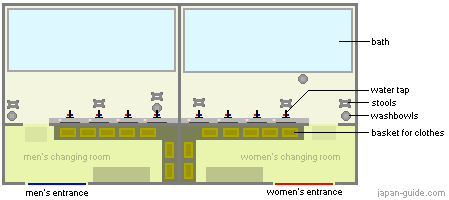Bucky went to Hakone to take a hot spring bath!
The town of Hakone is situated in the southwestern part of Kanagawa, and is part of Fuji Hakone Izu National Park. Hakone is an internationally well-known holiday resort.

Tenpra
Put grated yam on the rice.
raw fish and grated yam with Japanese horseradish
The town of Hakone is situated in the southwestern part of Kanagawa, and is part of Fuji Hakone Izu National Park. Hakone is an internationally well-known holiday resort.
How to take a bath
Below is a description of the most common way of taking a bath in a hot spring or public bath in Japan. The actual rules may differ slighly between baths, but if you follow the instructions below, you should be alright most of the time.
Typical layout of a small indoor hot spring bath: 
| 1) | Take off all your clothes in the changing room and place them into a basket together with your bath towel. Coin lockers for valuables are often available. |
| 2) | Japanese hot springs are enjoyed naked. Swimming suits are not allowed in most places. However, it is the custom to bring a small towel into the bathing area, with which you can enhance your privacy while outside of the water. Once you enter the bath, keep the towel out of the water. |
| 3) | Before entering the bath, rinse your body with water from either a tap or the bath using a washbowl provided in the bathing area. Traditionally, just rinsing your body is considered sufficient (and many older baths do not even provide showers and soap), but particularly among younger bathers you will find an increasing number of people who insist on taking a shower before entering the bath these days. |
| 4) | Enter the bath and soak for a while. Note that the bath water can be very hot (typical temperatures are 40 to 44 degrees). If it feels too hot, try to enter very slowly and move as little as possible. |
| 5) | After soaking for a while, get out of the bath and wash your body with soap at a water tap, while sitting on a stool. Soap and shampoo are provided in some baths. Like in private Japanese bathrooms, make sure that no soap gets into the bath water. Tidy up your space after you finished cleaning your body. |
| 6) | Re-enter the bath and soak some more. |
| 7) | After you finished soaking, do not rinse your body with tap water, for the hot spring water's minerals to have full effect on your body. from http://www.japan-guide.com/e/e2292_how.html |
Tenpra
boiled baley and rice
Put grated yam on the rice.
raw fish and grated yam with Japanese horseradish
Cha-soba(buckwheat noodle)
Tatami-room
Traditoinal style
Ikebana (Flower arrangement)
Hello, Bucky!














































































